June 6, 2008
Air Date: June 6, 2008
FULL SHOW
SEGMENTS
Global Warming Gridlock
/ Jeff YoungView the page for this story
An historic bill to cut the country’s greenhouse gases finally reached the Senate floor, only to fall victim to a filibuster. Living on Earth’s Jeff Young explains how Washington hot air stopped the global warming bill. (06:30)
Don't Mess with Texas Wind
View the page for this story
Eighty-year-old Texas oil billionaire T. Boone Pickens is feeling the green breeze – he’s putting 12 billion dollars into what will be the world’s largest wind farm. Pickens tells host Bruce Gellerman about the project that will power one million homes, and help with U.S. energy (05:30)
Green Plays in China
/ Elise PotakaView the page for this story
Investors have been pouring money into clean technology. Elise Potaka reports that money is increasingly following the technology to China. (07:00)
Clean Tech Cleans Up
View the page for this story
Investors are pumping billions into clean technologies, but could the growing market for industries such as wind and solar be primed for a pop? Host Bruce Gellerman talks with market analyst Ted Sullivan of Lux Research about clean tech "boomlets" and the future of green investing. (03:50)
Green TV, 24 Hours a Day
View the page for this story
Twenty-four hours of environmental programming. That's what's on tap for the new television network Planet Green. Eileen O'Neil is president of Planet Green. She tells host Bruce Gellerman the channel is eco-tainment for the eco-household. (06:40)
Letters from Listeners
View the page for this story
Living on Earth dips into the mailbag to hear from our listeners. (02:40)
The Zoo on the Road to Nablus
View the page for this story
The only remaining zoo in the West Bank opened in 1986, a year before the first Palestinian intifada. Amelia Thomas tells the story of how it's survived the violence and poverty of the occupied territory in her new book "The Zoo on the Road to Nablus: A Story of Survival from the West Bank." Living on Earth host Bruce Gellerman talks with Thomas about the animals and people that keep the zoo open. (07:45)
Out of This World Art
View the page for this story
In one Napa, California classroom, art means giving away energy-efficient light bulbs, videotaping green public service announcements, and powering up courtesy of student bicyclists. Host Bruce Gellerman talks with art teacher-extraordinaire, Sharon Campbell. (07:00)
Show Credits and Funders
Show Transcript
Host: Bruce Gellerman
Guests: T. Boone Pickens, Ted Sullivan, Eileen O’Neil, Amelia Thomas, Sharon Campbell
Reporters: Jeff Young, Elise Potaka
[THEME]
GELLERMAN: From Public Radio International - this is Living on Earth.
[THEME]
GELLERMAN: I’m Bruce Gellerman. A bill to fight Climate Change gets a bumpy ride on Capitol Hill – As some Senators turn to political procedures to derail the proposal.
KERRY: This deserves a better debate. And it’s really sad that the world’s greatest deliberative body has been reduced to tricks and gimmicks and parliamentary games rather than an honest debate on the future of our country and the future of this issue.
GELLERMAN: Coming up – the heated debate over climate change puts public policy in the back seat. Also, oil billionaire T. Boone Pickens sours on sweet crude in favor of wind power.
PICKENS: The wind has to be developed in the United States. I think everyone can see that we're going to break the country if we pay 700 billion dollars a year for imported oil.
GELLERMAN: Texas tycoon T. Boone Pickens picks wind as the next very big thing. These stories, this week on Living on Earth. Stick around!
[NPR NEWSCAST: Boards Of Canada “Zoetrope” from “In A Beautiful Place Out In The Country” (Warp Records 2000)]
Global Warming Gridlock

Senator Joe Lieberman helped draft the climate bill. (Courtesy of the National Wildlife Federation)
GELLERMAN: From the Jennifer and Ted Stanley Studios in Somerville, Massachusetts, this is Living on Earth. I’m Bruce Gellerman, in for Steve Curwood.
Call it global warming gridlock. Finally, an historic bill to reduce the greenhouse gases causing global climate change reached the floor of the U.S. Senate, only to fall victim to another form of hot air, the filibuster. Our Washington correspondent Jeff Young watched it go down. Hi, Jeff.
YOUNG: Hi Bruce.
GELLERMAN: The heart of this bill as I understand it, was the cap and trade approach, right?
YOUNG: That’s right. Cap and trade in a nutshell is—you set an overall limit on emissions, that’s your cap, then you let companies buy and sell emissions credits, and that’s the trade. The goal here was cutting greenhouse gases by about 65 percent by the middle of the century.
GELLERMAN: Hmm. And the bill was proposed by Senators Joe Lieberman and Republican John Warner.
YOUNG: That’s right. So you had a Republican, Warner; and independent, Lieberman; and the Democratic leadership behind this. However, it faced very tough opposition and even if it did pass, President Bush said he’d veto it. So there weren’t a lot of people expecting this to become law. However, we did expect to at least hear a serious, substantial debate on this. Instead, we heard this:

Senator Barbara Boxer speaking for Congressional action on climate change. (Courtesy of the National Wildlife Federation)
GELLERMAN: (laughing) Jeff, what’s that?
YOUNG: That’s one of the clerks of the Senate reading the bill word for word. Republican leader Senator Mitch McConnell ignored the normal protocol and insisted that the whole bill be read aloud—all 490, or so, pages of it.
GELLERMAN: Oh the poor clerk. How long did that take, Jeff?
YOUNG: About nine hours. Yeah, we were passing the hat here to buy the poor clerk some throat lozenges. But seriously, this was a form of obstruction by the Republican leaders in the Senate that filibustered the bill. Democrats did not have the votes to break the filibuster. And Democrats who supported it were understandably pretty upset. Here’s John Kerry of Massachusetts.
KERRY: This deserves a better debate. And it’s really sad that the world’s greatest deliberative body has been reduced to tricks and gimmicks and parliamentary games, rather than an honest debate on the future of our country and the future of this issue.
GELLERMAN: Hmm. Jeff, what did Republican leaders say was the reason for blocking this?
YOUNG: Well they disagreed with Democrats on how to proceed with debate. There was even a completely unrelated fight about judges. But, you know, bottom line here, Senator McConnell, the Republican leader, opposes a mandatory cap on greenhouse gases. And he and other Republicans, they just kept hammering the Democrats on one point, energy costs.
MCCONNELL: We’re amazed that they’re calling this bill up at this particular time. I mean it’s a stunning thing to behold. With gas prices being the number one issue in America they bring up a bill that objective analysis concludes is gonna raise gas taxes 53 cents.
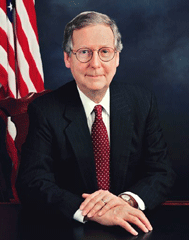
Senator Mitch McConnell. (Courtesy of Mitch McConell)
YOUNG: There are economic models that predict that, but what Sen. McConnell conveniently leaves out is the time frame for that prediction—it’s a 53 cent increase by the year 2030. So that breaks down to about two cents a gallon a year.
GELLERMAN: Well it’s gone up a buck just in the past few months.
YOUNG: Well, that’s exactly the pushback from the Democrats who favor this bill. And they say, look, this bill is gonna invest, more in fuel efficient cars and alternative fuels so in the long run we’re gonna end up using less oil.
GELLERMAN: I’m a little confused here, Jeff, because John McCain, the Republican nominee for president, he supports this idea of using cap and trade right?
YOUNG: He had not yet endorsed this bill just yet, but McCain is a very strong supporter of this kind of action on global warming, yes.
GELLERMAN: So wouldn’t you have had Republicans against Republicans on this issue?
YOUNG: Indeed you would have. And I asked McConnell about that.
MCCONNELL: Well, I think Senator McCain can speak for himself; we’re here to speak for us.
YOUNG: And uh, so here I think we’re getting to the real reason the debate was cut short. This is very divisive for Republicans. It’s also divisive for some Democrats. You got a lot of coal state Democrats who would prefer this just kind of go away. So on the surface you had this partisan bickering, but if you look just a little deeper you see, wait a minute, this really isn't about what party they’re from, it’s about which state they’re from.

Senator Joe Lieberman helped draft the climate bill. (Courtesy of the National Wildlife Federation)
YOUNG: I spoke with Kent Conrad, and he’s a Democrat from North Dakota—there’s a state with a lot of coal, oil, gas. He opposed the bill, but he was looking forward to the debate to see, you know, what kind of global warming action can he support. Because, you know, everybody knows, this is going to be back next year—all the presidential candidates pledged to act on this. And Conrad used a baseball metaphor.
CONRAD: This is a time to test out ideas, it’s a time to negotiate, to talk about things that are needed to improve this approach. So I see this as spring training for next year. And, spring training is important.
YOUNG: Can I carry your spring training analogy a step further: next year come the real season, are you on the roster?
CONRAD: Ha ha. I never negotiate in public. Ha ha.
GELLERMAN: (laughs) What about the Republicans—not the leadership but the rank and file members—where are they on this?
YOUNG: You know, it’s very interesting. There’s a lot of change afoot. I got some time with Senator Bob Corker, Republican from Tennessee—you know, we just heard earlier the Republican leader McConnell saying, uh you can’t talk about this when gas prices are so high. Well here’s how Corker sees it.
CORKER: A lot of my colleagues would say that this is the wrong time to be talking about legislation of this type because gasoline is at four dollars a gallon. I think this is the perfect time to be talking about it.
GELLERMAN: Doesn’t sound like he’s toeing the party line there, Jeff.
YOUNG: Not at all. But, you know, sadly we’re not going to hear the kind of debate that Senators like Corker and Conrad wanted to have on important matters. You know, what to do about coal? How about nuclear power? How do you deal with competition from China? Things like that.
GELLERMAN: So Jeff, is that it for climate change in Congress this year, you think?
YOUNG: It’s probably it for the Senate. But things are just getting cooking over in the House. Democrat Ed Markey of Massachusetts has introduced a very aggressive climate change bill. It’s a challenge to other House Democrats to get moving on this. We’ll have hearings later this month in the House on climate change, and we’ll see what happens.
GELLERMAN: Well, thank you very much, Jeff. I really appreciate it.
YOUNG: You’re welcome, Bruce.
GELLERMAN: Living on Earth’s Washington correspondent Jeff Young.
|
**WEB EXTRA** LIEBERMAN WARNER BILL VOTE ANALYSIS by LOE Washington Correspondent Jeff Young - The Republican-led filibuster meant the Climate Security Act by Senators Barbara Boxer (D-CA), Joe Lieberman (I-CN), and John Warner (R-VA), never reached a full debate or final vote. There are, however, very interesting things to learn here, especially in the vote to try to break the filibuster. It takes three-fifths of the Senate to end a filibuster (officially called a cloture vote). The final vote on this bill was 48 for and 36 against, far short of the magic number of 60. However, six absent Senators (including presidential candidates Barack Obama (D-IL) and John McCain (R-AZ) sent letters for the record indicating that if present they would have voted for the bill. That allowed the bill’s proponents to claim 54 supporters—the first time a majority of the Senate has gone on record in support of specific action on climate change. Here’s how the vote broke down: It was a partisan vote except for the following Senators who crossed party lines. These Democrats voted NO (against ending the filibuster): Sherrod Brown (OH), Byron Dorgan (ND), Mary Landrieu (LA), and Tim Johnson (SD). These Republicans voted YES (to end the filibuster): Susan Collins (ME), Elizabeth Dole (NC), Mel Martinez (FL), Gordon Smith (OR), John Sununu (NH),Olympia Snowe (ME) and, of course Sen. Warner. (Republicans McCain and Norm Coleman (MN) were not present but indicated they would have voted to end the filibuster). Now, the savvy political observer will look to those politicians who face tough reelection contests. That’s where you will find how an issue is really playing.Republicans Collins, Coleman, Dole, Smith and Sununu all face reelection and all voted for action on climate change. Clearly, they feel it’s important to show their constituents they will act on global warming even if it means defying their party leadership. Democrats Johnson and Landrieu are also in tight races and voted against the bill, presumably out of concern for the energy interests in their states. Aside from domestic politics, the vote also sends an international signal. Developing nations like China now see that a majority of the U.S. Senate and presidential candidates from both parties favor specific action on global warming. This may well impact upcoming rounds of international talks. The funds that were raised at the Blue Auction will be used directly to benefit three marine conservation programs in Indonesia: The Marine Empowerment Initiative, The Marine Enforcement Initiative and The Marine Conservation Education Initiative.
Related links:
Don't Mess with Texas Wind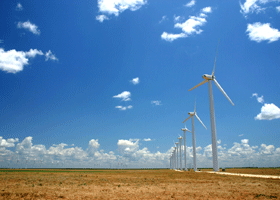
A wind farm in Scurry County, West Texas. Pickens’ wind farm may be one of many wind farms in Texas, but with a 4,000 megawatt generating capacity, it’ll be the biggest. (Photo: Sarah Fields) GELLERMAN: Well now from the halls of Congress where they’re debating energy proposals – to Texas, where energy is big business. And one of the biggest players in that business is T. Boone Pickens. The oil tycoon started out as a small time driller in the 1950’s and parlayed his stake in petroleum into an empire, turning him into one of the richest people on the planet. But now Pickens is turning away from oil – and into wind. This month he put down the first installment on a billion dollars worth of wind turbines. It’s part of his ambitious plan to turn 200 thousand acres of the Texas Panhandle into the world’s biggest wind generating power plant. Mr. Pickens, welcome to Living on Earth! PICKENS: Good, thank you. GELLERMAN: Mr. Pickens, you're a petroleum guy, right? PICKENS: That's right. GELLERMAN: So...why you pickin' up the green patina and going with, you know, wind energy? 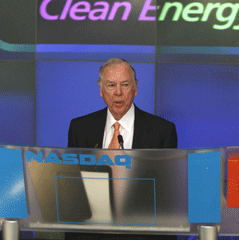 T. Boone Pickens talks about his company Clean Energy at the Nasdaq. (Courtesy of T. Boone Pickens) GELLERMAN: So how big is your project? PICKENS: It's big. It's a uh, I think it's the largest wind farm in the world. It'll be 4000 megawatts, which will be about probably two pretty good nuclear plants. So, it'll service a million, three-hundred thousand homes, and it'll be about a 10 billion dollar project without the transmission, and we probably will do the transmission, and that’d be another two billion – so, total cost would be 12 billion dollars. GELLERMAN: Now it's pretty unusual for somebody to bankroll the transmission lines. PICKENS: It is. That is unusual, I agree. GELLERMAN: Well, why don't you let somebody else pay for it, like the transmission people? PICKENS: Well, it, everything goes slower if I do that. So to fit the schedule of when we're gonna be ready to start spinning, which will be the last of 2011, we need to have transmission in place at that time, and this is the only way we can time it to work that way. And, see, everything has gotta happen fast for me, because I'm 80 years old. GELLERMAN: Now I'm sure you're aware that at the end of this year the federal wind energy production tax credits expire - Congress has not voted on them. PICKENS: Well, that, I think they'll vote on it. They'll either do that or they'll give some kind of carbon credit because, the wind has to be developed in the United States. We're not importing 72 percent of the oil we use every day. I think everybody can see that we're gonna break the country if we pay 700 billion dollars a year for, uh, imported oil.  A wind farm in Scurry County, West Texas. Pickens’ wind farm may be one of many wind farms in Texas, but with a 4,000 megawatt generating capacity, it’ll be the biggest. (Photo: Sarah Fields) PICKENS: That's it. GELLERMAN: Hmm. But the president has been against this because he wants to use tax credits not for alternative energies like wind, but for, you know, petroleum, which you're also invested in. PICKENS: Well, but the president won't be around, though, for very much longer. GELLERMAN: Uh huh, so you're banking on another president taking— PICKENS: Well, I'm banking on Congress passing the production tax credit, yes. GELLERMAN: I know you're a big quail hunter, right? PICKENS: I'm a quail hunter, yes. GELLERMAN: What about your concern about birds getting caught in the blades of these turbines? PICKENS: You know, do you know how high these things are? The hub on the turbine is 280 feet up, and then the radius on the blade is another 120 feet. So you're 280 plus 120 - you're 400 feet up on this to the tip - you know, that's a 40 story building. It would have nothing to do with quail, quail don't fly that high. But we're not in flyways, where you have, you know, migration through this area, so you don't have that many birds. I don't, I think you kill more birds on the window at my ranch house, and they do fly into the window, and I bet you kill more birds on the windows of buildings and houses and all than you ever would off the blades on those windmills. 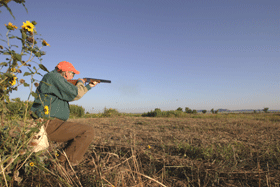 T. Boone Pickens hunts for quail at his Mesa Vista Ranch in the Texas Panhandle. (Photo: Wyman Meinzer, Courtesy of T. Boone Pickens) PICKENS: Keeps me up at night? I sleep. I'm not up at night. Well, I don't worry about things. I have, from time to time I have concerns about things, but not, I don't worry. And I don’t know, I mean what concerns me about it? I think we've got it well analyzed, I've got a good team of people that are knowledgeable in wind energy, and I don't worry about it. I think it's a good project, and it'll do well and we'll make money. And it'll help the country. GELLERMAN: Mr. Pickens, I know you're a big basketball fan. I know you were once thinking about becoming a college coach. Who do you pick in the finals, Celtics or Lakers? PICKENS: I pick Celtics. GELLERMAN: Oh, good man! You're gonna put money on the game? PICKENS: No, I don't bet on sports. GELLERMAN: (laughs) PICKENS: I've got a big enough bet on the wind. GELLERMAN: Well, Mr. Pickens, thank you very much. PICKENS: Good. I enjoyed the visit. GELLERMAN: Texas wind tycoon, T Boone Pickens. [MUSIC: Jimi Hendrix “The New Rising Sun” from ‘Voodoo Soup’ (MCA Records 1995)] GELLERMAN: Coming up: turning greenbacks in to green bucks – investing in the next big thing. That’s straight ahead on Living on Earth. [MUSIC: John Ellis: “Three Legged Tango In Jackson Sq.” from Dance Like There’s No Tomorrow (Hyena Records 2008)] Green Plays in China
Solar panels in Kunming, China. (Photo: Matthijs Koster) GELLERMAN: It’s Living on Earth, I’m Bruce Gellerman. While China’s economy is booming, its environment is paying the price. The nation’s air and waterways are choking with pollution – industrial waste is poisoning the population, and coal, which provides 70 percent of China’s energy, has helped turn it into the world’s largest emitter of greenhouse gases. But now, China’s leadership is trying to clean things up, hoping to increase industrial energy efficiency by 20 percent, with a healthy dose of clean technology. The effort has caught the eye of some savvy investors as Elise Potaka reports from Beijing. [SPRINKLER SOUNDS, AIR CONDITIONER POWERING UP] POTAKA: As the days turn warmer in Beijing, air conditioners, which now line the sides of most buildings, come to life. On this summer’s hottest days, many Chinese cities, will struggle to cope with the rising energy demands of the country’s increasingly affluent citizens. The International Energy Agency predicts that China’s electricity production will double in the next ten years. [CROWD SOUNDS, VOICES SPEAKING MANDARIN] POTAKA: But for China’s 1.3 billion people, this demand also offers opportunity, one which could give them a cleaner, greener future. Across the world, investors and entrepreneurs are starting to see dollar signs attached to China’s struggle to reduce energy consumption and clean up its environment. [HOTEL LOBBY SOUNDS] POTAKA: David Wu checks his emails and sips a cool drink in the lobby of one of Beijing’s upmarket hotels. Since he returned from studying abroad, David’s rarely had time to sit still. In the last 12 months, his new company, Netpower, has closed ten million dollars in deals for affordable batteries he says can be used in both residential and industrial situations. WU: By using electricity storage, we can use the electricity in off-peak hours, and store it, and make it to be released into the grid in the peak hours. 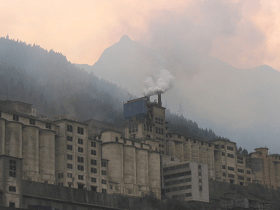 A coal-burning concrete plant near the Yangtze River. Coal supplies about 70 percent of China’s energy production. (Photo: David Dewey) He hopes the affordability will also appeal to electrical utilities and allow them to buy more power from renewable sources. WU: For the wind, for solar, they’re essentially not a stable source. Uh, so the utility company has a lot problem by handling those unstable electricity inputs. By using storage solutions we can essentially stabilize the output for wind farms and for the solar farms. POTAKA: David Wu is just one of China’s new cleantech entrepreneurs. Behind these entrepreneurs is a growing pool of money, much of it supplied by overseas venture capitalists. Between 2005 and 2006, cleantech investment increased by 147 percent reaching around 420 million dollars and analysts predict this trend will continue. MAHONEY: We’re developing the community of investors, companies, entrepreneurs that are interested in clean tech, and we’re bringing them together. Jim Mahoney is the managing director of Cleantech Group China, a company, which links those with money to those with green technology ideas. MAHONEY: We are accelerating the purchase and adoption of these clean technologies by industries at large, which, as you increase that scale, you can lower costs, you can speed up the return to investors and the whole cycle speeds up and grows from that. POTAKA: Currently, the global Cleantech Group claims over 8,000 investors and 6,000 companies across a wide range of projects. MAHONEY: Water applications for conservation, for treatment for reuse and recycling are, is a very, very important area. Biodegradable plastics was another one, I thought, wow! [CONSTRUCTION SOUNDS] POTAKA: An office block is under construction in Beijing’s rapidly expanding Central Business District. With labor and construction costs low, China is also turning out to be a major player in the market for carbon offsets. That’s where companies in the developed world get credits for reducing greenhouse gas emissions in the developing world. China is already the top supplier of credits, and foreign investors and companies are keen to get in. On the northern edge of the Central Business District are the offices for Camco China, a joint venture, which is responsible for offering about 30 percent of China’s carbon credits. Managing director, Alan Ho. HO: There are two major areas that we help in this sector. One is energy efficiency, where we help the enterprise to save using energy. Another one is to find alternate energy sources, renewable and new energy.  Solar panels in Kunming, China. (Photo: Matthijs Koster) Investors are backing environmental technologies, which are cleaner than what’s currently in place, but some environmental groups want the standard to be higher. [VOICES, SOUND OF DISHES IN OFFICE KITCHEN] POTAKA: At the Greenpeace Beijing office, employees have a coffee break and take in the 19th floor view across the city. On a good day, the view’s spectacular. On a not so good day, the heavy brown haze of pollution is clearly visible. Greenpeace has just started a green investment campaign. TAM: Our financial leg to support this work is to ask investors to channel their money from nuclear, from coal fired power plants that create more emissions than we can afford, ah to renewables, like wind and solar. POTAKA: Campaigner Man Kei Tam says Greenpeace would like to see investors backing renewable and new energy over, for example, reducing emissions in a new coal-fired power plant. By making direct contact with potential investors, Greenpeace wants to convince them to back the most environmentally friendly options. They’ll also target investors here in China who’ve been much slower than their international counterparts to invest in clean tech and green projects. Man Kei Tam says it’s about convincing people that protecting the environment will save them money. TAM: It’s like, the environment can be a risk to them, that effects their financial bottom lines. Say, for example, a factory if it pollutes a river, they will be asked to close, their license can be suspended, they will be fined billions of dollars and all these are related to financial performances, this is economic, it’s not just some moral concerns. POTAKA: For Living on Earth, I’m Elise Potaka in Beijing.
Clean Tech Cleans Up
The sun reflects off of solar panels in Arizona. Some market analysts foresee the supply of solar panels outstripping demand for them next year, popping the solar energy bubble. (Photo: Jackie Beck) GELLERMAN: Well, China isn't the only country in the world where investors are pumping billions into clean technology. Here in the United States, in 2000, the year when the dot com boom went bust, venture capitalists began funding clean tech big time. [BALLOON INFLATING] GELLERMAN: By 2005 clean tech investments had expanded by half a billion dollars. [BALLOON INFLATING] GELLERMAN: And the very next year, U.S. venture capitalists got even more serious, inflating their clean tech investment portfolios three fold. [BALLOON INFLATING] GELLERMAN: And by 2007, things got really big, especially for solar. Maybe too big? [POP SOUND] GELLERMAN: Market analyst Ted Sullivan says we’re in a solar bubble that could burst next year, as the supply of solar panels exceeds demand. Sullivan, a senior analyst with Lux Research, believes clean technologies have a bright future, but investors should prepare for a bumpy ride. SULLIVAN: The way that we look at the mark is it's a series of cascading boomlets, if you will. So the number of technologies which are taking their turn, kind of coming into vogue - and as they get bigger and as they scale, there's more light shone upon them, and some of the key technology issues become very apparent, and at which point, um, they kind of come back to a base level. 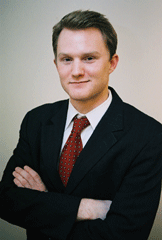 Ted Sullivan is a senior analyst with Lux Research, an independent firm that researches emerging markets. (Courtesy of Ted Sullivan) SULLIVAN: Whereas in the past we've seen, first in 2005, 2006 we saw biofuels, today we're kind of at the end of the solar boomlet, and things are coming back within rational bounds. The next two that we're watching are really the energy storage sector - so new batteries, new battery technologies. The drivers of that are a few. The first is the shift towards plug-in hybrid electric vehicles. There's been a lot of rumblings recently about the Chevy Volt, and we're watching Boston-based A123Systems as being really kind of the lead-off IPO that will announce the emergence of the energy storage space. A number of prominent venture capitalists who we talked to are beginning to, and have been for the past year or so, been hungrily scavenging deals in the energy storage space, in order to get a play there. GELLERMAN: Well, how much of the clean energies and environmental technologies is real, and how much is mania, particularly in terms of money? SULLIVAN: I would argue that things are pretty real, and the reason that is, is because compared to the dot com boom, you really need to have some technology there. You can't just put a couple kids in a warehouse and have them program night and day for a couple of months and turn out a product that has questionable value. In order to get, build up solar installations, wind turbines, in order to produce batteries and actually get them installed in plug-in hybrid electric vehicles, um, there's some real technology there, and so for them actually to get built out, there needs to be a real value proposition there. GELLERMAN: Now, as the price of oil goes up and up and up, doesn't it make alternative energy technologies more attractive? SULLIVAN: Certainly. That is the large-scale driver behind solar or wind, biofuels, etc. And that's really why these technologies are here to stay. The higher that oil and natural gas prices are for longer, the more incentive for start-up companies, for innovators to jump into the market.  The sun reflects off of solar panels in Arizona. Some market analysts foresee the supply of solar panels outstripping demand for them next year, popping the solar energy bubble. (Photo: Jackie Beck) SULLIVAN: Yeah, I think it's very interesting to see a Texas oilman finally wake up and realize that there really are some forces at play here. If you look, too, T. Boone Pickens is starting to get into the water market. He's buying up aquifers in the Texas and the Southwest, and in addition to energy storage, we're looking at water as being one of the next of these little boomlets. All these energy technologies to some degree either require the use of water - so basically parts of the greater renewable energy system, um, that need to come on line and be viable in order for the entire system to work. GELLERMAN: Well, Mr. Sullivan, thanks a lot. SULLIVAN: Thank you so much, Bruce. GELLERMAN: Ted Sullivan is a senior analyst with the market research firm, Lux Research. [MUSIC: Beastie Boys “Off The Grid” from ‘The Mix Up’ (Capitol Records – 2007)] Green TV, 24 Hours a Day
Maria Menounos covers green celebrities as host of the Planet Green series “Hollywood Green.” (Courtesy of Discovery Communications) GELLERMAN: Television has been broadcasting in color for nearly 50 years, but only now has it gone green. Debuting on cable TV is Planet Green, featuring all things green, all the time – from beauty products to pop stars. LEE: I’m Tommy Lee, what’s up? LUDACRIS: What’s the deal? You got Ludacris right here and I already know what everybody’s thinking. They’re thinking, what do rappers and rockers have in common. You know? LEE: Life in the fast lane, dude. LUDACRIS: Living in the fast lane? LEE: Yeah. LUDACRIS: That might be true, but I’m gonna tell you we gotta slow our role to make sure that we secure our futures. LEE: We’re trying to do our part. Now you can join us by recycling today. LUDACRIS: One bottle, or can at a time, can really make a difference. LEE: And when you’re kicking back at home, check out Discovery’s new network, it’s called-- LUDACRIS: Planet Green. Starting on Wednesday June, 4. And make sure you look for us trying to out laugh each other on Battle Ground Earth. GELLERMAN: Well, 50 million U.S. households will be able to do just that. Planet Green president and General Manager Eileen O’Neil promises the cable channel will provide 24-7 eco-tainment programming for an eco-lifestyle. 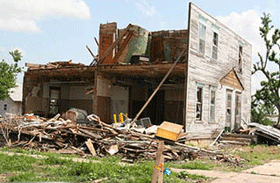 The series Greensburg will document the green reconstruction of a Kansas community destroyed by a tornado. (Courtesy of Discovery Communiations) GELLERMAN: So eco-tainment. Eco-lifestyle. O’NEIL: Yes. GELLERMAN: Do you have any fears that you might be watering down the whole notion of green? O’NEIL: You know, we really wanted to take what is, you know, the substance and the core science and research that, you know, has finally really come to the mainstream, and put it in a context and a filter that would engage even more people. You know, it felt like we needed to give something that was entertaining, because that's what television is so good at delivering, and also really personally relevant. We wanted to really bring that entertainment into our households, and how it relates to the individual and what we can all do in changing our lifestyles in various ways, cause, you know, we're all in a different stage of the green spectrum, and we just want to keep pushing people further along the spectrum. GELLERMAN: I went online and took a peek and a preview of what's coming up, and I noticed that you have a lot of partnerships, but some of your underwriters, I don't think of them as being very green companies - I'm thinking of General Motors, you have Caterpillar. 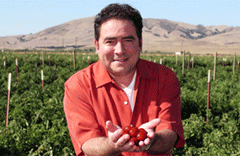 Emeril Lagasse’s new series Emeril Green will debut on Planet Green in July. In the show Emeril will help people make eco-friendly choices about food. (Courtesy of Discovery Communications) GELLERMAN: But could it be green by association? I'm thinking of a company that might want to appear green, and so they associate with you, but they're not really green. O’NEIL: Yeah, we take our relationship with advertisers very seriously, and we have very thoughtful conversations with each of our advertisers to understand, you know, what their commitment is and what their goals are and how they can match up with ours as well, and, um, really try to come up with a message that makes sense and is authentic as possible.  Maria Menounos covers green celebrities as host of the Planet Green series “Hollywood Green.” (Courtesy of Discovery Communications) [Music and sound from promo video: Man: "This is a once in a lifetime opportunity to be the first model green community in the world"... Woman: "Greenburg's rebuilding, I think will be ok"... Man: "Welcome to Greensburg. Please join us as we build a green American dream."] O’NEIL: Yes, I'm very proud of that series. We met with the town shortly after their devastating tragedy last year, where I think nine persons were lost, and then 95 percent of the physical property in the town was destroyed. And we met with the townsfolk in early June and had the privilege to really chronicle their rebuilding process, that they had focused themselves on rebuilding green. One of the things that they had said to me when we first met that really struck me is, you know, they're middle America, and they felt that this was an opportunity to be a role model for, um, the U.S. in the way that there's a perception that green has a particularly strong interest or focus on our coasts, and that it's something that middle America doesn't really, you know, pay attention to or appreciate. And they really have seen themselves as a role model, and it's been a great experience with them to see the green movement through their eyes. GELLERMAN: Ms. O’Neil, do you have a favorite program coming up? O’NEIL: (laughs) That's not a fair question. I love all my babies. And, you know what's so hard is, the line up is very diverse. We want something there for everyone, and we've not really defined our audience by a sharp demographic, but more psychographics. So I'm looking at certainly different genders, but different age groups and life stages, so I'm looking forward to them finally reaching air, whether it's in June with the shows like Greensburg, to July when Bob Woodruff's series from ABC News launches and Emeril Lagasse’s Whole Foods series, and then kind of a monster of an entertainment series, the Battleground Earth with Ludacris and Tommy Lee in August. So, um, I love them all (laughs), and I hope a lot of other people will too. GELLERMAN: Well, Ms. O'Neil, congratulations, and best of luck! O’NEIL: Thank you very much. GELLERMAN: Eileen O'Neil is the president and general manager of Planet Green. [MUSIC: Vibraphonic “I See You” from ‘Acid Jazz Rarities’ (Acid Jazz Records –2004)] [MUSIC: Endangered Species: “Coyote Running” from Dancing In The Trance (Global Pacific 1995)] Letters from ListenersGELLERMAN: It’s Living on Earth. I’m Bruce Gellerman. [LETTERS THEME] GELLERMAN: Now it’s your turn – we open the LOE mailbox. One Green listener, actually, Jim Green, wrote in. He catches our program online and hauled us over the coals for our story about which was the more eco-friendly way to cook outdoors: gas or charcoal. “I was disappointed that your oxymoronic piece on ‘green grilling’ didn't address the bigger problem” – he writes – “what is being grilled? From what I've read reducing meat consumption is something (and perhaps the most useful thing) everyone can do to reduce greenhouse gasses.” GELLERMAN: Several vegetarian listeners skewered us on the same point – including James Van Allstine of the Mid-Hudson Vegetarian Society. He hears us on WAMC in Albany, New York, and cites a Cornell University study that shows the amount of grain consumed by U.S. livestock could feed over 800 million hungry people. Jim says that’s enough calories to end world hunger. Another WAMC listener found our story about National Train Day on track. Diane Crane called our comment line. CRANE: When I heard that investors were starting to make inroads investing in rails again, I nearly stood up and cheered. There are too many trucks on the road. I think the rails should carry freight and people – Europe does it – why can’t we? GELLERMAN: Our “Cool Fix for a Hot Planet” from listener Steve McArthur drew a lot of attention. Steve makes his refrigerator more energy efficient by encasing it in styrofoam. But Carol Springer in Connecticut thought styrofoam might be a baaaad idea and proposed a green alternative. The WNPR listener uses 100 percent wool insulation on her fridge. It’s called “Whisper Wool Underlayment.” After hearing our story on WHYY, the whole idea of wrapping a refrigerator gave Dan LeFevre an itch to call us. LEFEVRE: A lot of refrigerators at one point, and a lot of freezers I think still do, have coils built into the surface on the inner side of the exterior case. So if you insulate it, you’d only be making it use more energy because it can’t expel its heat. GELLERMAN: Well, thanks Dan. And if you’re hot under the collar about something you hear on Living on Earth – have a yarn to spin – or just want us to stop making puns – don’t be sheepish – our email address is comments @ loe.org. And for our listeners – we’re always all ears. Call 800-218-9988. That's 800-218-9988.
The Zoo on the Road to Nablus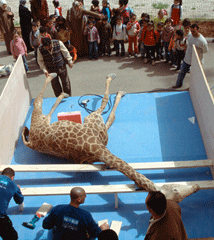
Brownie the giraffe died in the Qalqilya Zoo after getting spooked by nearby gunfire. (Photo: Peter Friedl) GELLERMAN: Zoos are fun, they’re educational, a normal part of childhood. But for a Palestinian kid living on the West Bank – the Qalqilya Zoo is much more – it’s a refuge from barricades, checkpoints and chaos. The Qalqilya Zoo has survived bombs and bullets – it’s the only zoo in the West Bank, and it’s run by the only zoo vet in the Palestinian territories. Amelia Thomas writes about the zoo-keeper and his animals in her new book "The Zoo on the Road to Nablus: A story of Survival from the West Bank." And she joins me now from Jerusalem. Welcome, Amelia. THOMAS: Thank you very much for having me. GELLERMAN: This is a very unlikely place to put a zoo at a very inopportune time. Why a zoo in Qalqilya? THOMAS: The zoo in Qalqilya is one of the only things now for the public to do in the West Bank. There's pretty much no other kind of leisure activities there at all. Qalqilya itself is a town on the very edge of the West Bank, so it's one of the closest towns to Israel. As a journalist I was intrigued by the idea that there could even be a zoo in Qalqilya in the West Bank, and I heard about it in a tiny little news article, a Palestinian news article, so I went to have a look and see if it was really true. And it was. 
THOMAS: (laughs) Ya, it's not what we could consider to be a zoo of any kind of Western caliber. It's a small zoo right in the center of town, so there's very little room for expansion there, and they've had to struggle against some pretty difficult situations – through two Intifadas where there's been a lot of shooting, a lot of curfews. But the head vet there, the only vet there, who's the only Palestinian zoo vet and who I follow in the story, has this dream to turn it into an international zoo, he calls it. GELLERMAN: Dr. Codder- or you call him Dr. Sammy - is sort of an unlikely heroic figure. THOMAS: (laughs) GELLERMAN: He's kind of rolly polly with a moustache, is the way I kind of envision him. THOMAS: (laughs) Yeah. He's, um, he’s not your average hero, definitely. He's, as you say, he's a little chubby, and a little scruffy as well, but he has been the one who has kept the zoo going through its hardest periods. Dr. Sammy's always sort of managed to find some way of looking on the positive side of even the direst of circumstances. When animals have been killed in a - especially in the Second Intifada, several animals were killed during fighting - instead of giving up and saying, well there's no way we're gonna get another zebra, he, he turned to stuffing them. GELLERMAN: He's a taxidermist and he starts stuffing the animals, and that's just ok with him, that's, you know, a solution. THOMAS: Ya. Because that meant that he would, he'd, okay! He'd start a natural history museum and make the best of a bad situation. GELLERMAN: He's got these rusting cages and rather than leave them empty, he finds some chickens and put them in there because he, 'you can't have a cage with no animals in them,' he says. THOMAS: That's right. The main reason that he keeps his zoo going is for, is for the people of the town and the people of the region when they can get there. And his idea is, you know, no one wants to see an empty cage. So if you have an empty cage, because an animal’s died or you can't get any new animals, find something to put in it. So, people of the town have brought in animals that they've found, so he's got a badger, and he's got some ducks. So in hardest times, a lot of the cages were filled with chickens. GELLERMAN: The town's surrounded by part of the security wall. THOMAS: That's right. It's almost surrounded 360 degrees by the security wall barrier, so it limits movement a lot. The only way in and out is one checkpoint, which is fairly regularly closed and is policed. GELLERMAN: How did you get back and forth through the security fence? THOMAS: As a journalist, you're allowed pretty much free access into the West Bank and into Israel and into Gaza. So I was allowed this kind of viewpoint that very few people really are allowed, and by traveling to and from Qalqilya fairly freely, it's kind of a tricky thing when you see yourself show a card and you go straight through, and you know that there's people in Qalqilya who haven't been allowed out of the town for years. They can't go and visit their relatives, they can't travel, they can't even get to the next town or to the places where they would traditionally have sent their goods to market. GELLERMAN: Is it overwrought to think that when writing this book, you used the zoo as a metaphor for Qalqilya? Am I reading too much into it? THOMAS: I think that that's absolutely true. I think, and it's not only a metaphor for Qalqilya but probably a metaphor for sort of the broader Palestinian situation and many situations within the Middle East where people are sort of caught up in what they would consider to be cages. GELLERMAN: One of the characters in the book is Ruti, the giraffe. THOMAS: Ya. GELLERMAN: And uh, her mate is murdered. THOMAS: Brownie was found for Ruti so that she'd have a mate, and it's very difficult to get any animals into Qalqilya at all, let alone a giraffe. So he was finally found for her, and slowly, they fell in love. She was the instigator. And during the Second Intifada one night, troops stationed themselves at a boy's school, which backs onto the zoo, and as darkness fell, started shooting into the zoo - we assume that was because they've spotted militants. And uh, the sound of the gunfire startled Brownie. He ran from the gunfire, hit his head on the door of the giraffe night enclosure, and that killed him unfortunately.  Brownie the giraffe died in the Qalqilya Zoo after getting spooked by nearby gunfire. (Photo: Peter Friedl) THOMAS: Yeah, zoos in wartime have always, they've always in a way reflected the situation of the country itself. During the Second World War, zoos in Britain, but also in Germany, suffered a lot under bombings, and what intrigued me a little bit more about the Palestinian situation rather than the other zoos was that in Qalqilya, nobody seemed to come in to help. In Iraq and in Afghanistan, international aid was sent in, people brought supplies for the animals, people brought vets, people donated to funds to help these zoos. And Qalqilya, they sort of seem to be a little bit forgotten. GELLERMAN: Well, there's this absurd quality to what's going on there. There's a man with a mission to build a zoo, and there's war going on, an Intifada. It just, it's so absurd. THOMAS: Often you do sort of look away for a minute when you read the newspaper or go out and to tell a story and just think how absurd the situation is in this region. One of the things that struck me particularly when I was, when I was writing this story and researching in Qalqilya, was that the contrast between one side of the security wall, inside Qalqilya, and the other side, outside Qalqilya in Israel, was so stark. You know, in one side of the fence, people are driving nice cars and drinking wine at lunchtime, and on the other side of the fence, really none of that is going on - people are going down the road in donkey carts - and so, yeah, there's an absolute absurdity to the situation. GELLERMAN: So what happens now, Amelia, what happens to the zoo now? THOMAS: Things have been slowly, gradually, improving. There's a point in the story where I talk about Dr. Sammy's new project, which is the 'Museum of Everything,' (laughs) which is his third museum. And his first museum was the natural history museum, the second museum was an agricultural museum, and after that he decided to broaden it out a little bit and create a museum of everything. And that's since opened, so he's created a huge Papier-mâché space shuttle and a massive dinosaur and a volcano, which allegedly erupts, although I've never seen it erupt. (laughs) And so he's, yeah he's pressing on and planning new things for a monkey enclosure, which is going to be a new enclosure for his fairly motley collection of monkeys. It's never easy to say what will happen in this region of the world, and things can change, you know, overnight. But he's tenacious, and he doesn't want to give up, and I think he'll keep on going until he gets what he wants. GELLERMAN: Amelia Thomas is a correspondent for the Christian Science Monitor, The Middle East Times, and Lonely Planet. Her new book is called, 'The Zoo on the Road to Nablus: A Story of Survival from the West Bank.' Amelia, thank you so much. THOMAS: Oh, thank you for having me. [MUSIC: Simon And Garfunkel “At The Zoo” from ‘Bookends’ (Columbia Records—1968) ] Out of This World Art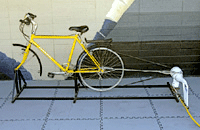
Sharon Campbell’s husband built a stationary bike that harnesses the energy of middle schoolers to power her classroom. (Photo: Oliver Laude) GELLERMAN: Sharon Campbell is no ordinary art teacher, and where she teaches is no ordinary classroom. It’s a spaceship headed for Mars. She calls it the RMS Energy Star. RMS stands for the Redwood Middle School. It’s in Napa, California, and it’s where Sharon Campbell’s mission to explore science, art, and conservation takes off daily. Hi Sharon. CAMPBELL: Hello Bruce. GELLERMAN: So why have you converted your classroom into a spaceship? CAMPBELL: Well, our classroom is our very largest tool for teaching, and my students don't like living in a beige classroom any more than an office-worker likes working in a beige office. Our colors are baby blue, hot pink, hot purple, silvers, golds. You can look out through the portholes, you can see Mars and you can see Saturn. GELLERMAN: You're doing more than just teaching art. CAMPBELL: Well about four years ago, something really exciting happened to me. I found something at a conference, it was called a Promethean board, and active board, and what it did was it allows me to teach to my students through sound, through sight. But our school district doesn't have any money, and yet I knew that it was exactly what I needed to meet the needs of every student in my class. So, I wrote a grant with the British Petroleum company—who gives money to individual teachers for innovative programs. And what I did was I looked at my husband and I said, 'Can you create a bicycle that will make electricity so I can run my classroom?' and my husband said, 'uh huh.' And I chose that because a, there's nothing more active than 14 seventh and eighth grade boys in each class. So I figured that they could use their excess energy and create electricity for my classroom, and I would have the money to build the bicycle and buy the Promethean board. 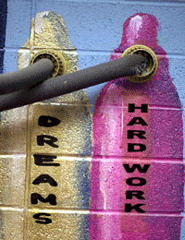 Dreams and hard work are the components of success fuel in Mrs. Campbell’s class. (Photo: Oliver Laude) CAMPBELL: Yes, and our sound system and our projector. The students pedal it for 15 minutes each hour, each period. So I have three students sign up, and they pedal for five minutes a piece, and they can go ahead and continue their projects or watch the lesson plan at the same time. GELLERMAN: Hmm. Well, let me speak to one of your student generators. CAMPBELL: Ok. GELLERMAN: So, what's your name? BRANDON: My name's Brandon Beck. I'm in seventh grade. GELLERMAN: So Brandon, do you ride the power-generating bike in the classroom? BRANDON: Yes I do. Everyday, whenever I can. GELLERMAN: Why don't you hop on the bike, and tell me what it's like to ride the bike. How’s that. [BIKE SOUNDS, CLASSROOM CHATTER] BRANDON: I like riding the bike because ever since I learned about global warming and, like, saving energy, that's been one of my main priorities because I'd like my kids to be able to like see a polar bear or a penguin, and I wouldn't like my house to be under 50 feet of water from all the melting that's happening.  Mrs. Campbell’s art room is painted to look like a spaceship. (Photo: Oliver Laude) THOMAS: My name's Thomas. GELLERMAN: Tom, what do you like about this class? Or, what you don't like about this class? THOMAS: Um, there's not much I don't like about this class. It's a fun class and you're really involved and you get to interact with all the things she has in this class. You get to learn how to edit the films, you get to learn how to conserve energy, you get to use the Promethean board. GELLERMAN: Well, give me an example how you conserve energy. THOMAS: One year for the Back to School Night, or the parent's night where the parents came back to class, instead of like giving them like coffee and a cookie or something, she gave every one of the parents a light bulb - an energy conservation light bulb. We also have competitions. Each period gets like, for every energy conservation thing that they did, they get an energy dollar and they get to put it in a jar of like what period they're in, and whatever period has the most dollars at the end of the months get like a prize or something. 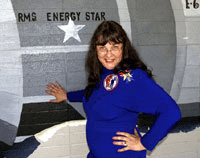 Mrs. Sharon Campbell is captain of the energy star at Redwood Middle School in Napa California. (Photo: Oliver Laude) THOMAS: Yeah. It's just a way of measuring like of what that period has done to uh conserve energy. GELLERMAN: So Mrs. Campbell, are all your crew members male? CAMPBELL: No, (laughing) we have crew members of both genders. And let me go get one of our young ladies. MEGAN: I'm Megan. I live in Napa, and I'm about, I'm thirteen actually. GELLERMAN: So tell me about your experience in Mrs. Campbell's class? What have you learned, and uh - ? MEGAN: I do lots of things here. It's so much fun, I mean there's always something to do. And she does a lot to conserve the energy. GELLERMAN: Megan, are there any lessons that you've learned in Mrs. Campbell's class that you've taken home with you and that's you've tried to teach to your parents?  Sharon Campbell’s husband built a stationary bike that harnesses the energy of middle schoolers to power her classroom. (Photo: Oliver Laude) GELLERMAN: (laughs) Well, that's gotta be a tough lesson. MEGAN: Yeah. GELLERMAN: (laughs) Well, Megan, thanks a lot. I appreciate it. MEGAN: You're welcome. GELLERMAN: Ms. Campbell, how has this project affected the community outside of your classroom? CAMPBELL: Well, the students sort of downplayed their role in the community. They are doing energy conservation commercials right now. We have some that are doing global warming, and we have, really one of the nicest is a race between the plastic bag, the reusable bag, and the paper bag. [From tape: STUDENT 1: Now, would you like paper or plastic? STUDENT 2: Umm, none. I brought my own. STUDENT 1: That's a good idea. Here you go. Bye. That's a good idea, maybe I...] CAMPBELL: We have some that are doing bright ideas, turn off the light. This fall, the students received a donation of 5000 energy conservation light bulbs from the Sylvania Company, and within two and a half days, they had placed every light bulb in a home in the Napa Valley. And then they took 500 bulbs and they wrapped them for Christmas, put ribbons on them, and we took them to the food bank, and we made sure that they went to the most needy households in the Valley as well. My students are concerned citizens even though they're eleven and twelve years old. In five years they'll be voters. The future's in great hands. GELLERMAN: Well, Ms. Campbell, thank you very much. CAMPBELL: Well, thank you for giving my students a voice. [CLASSROOM SOUNDS] GELLERMAN: Sharon Campbell teaches at the Redwood Middle School in Napa, California. At our website, LOE.org, you’ll find pictures of her spaceship classroom – it’s out of this world.
GELLERMAN: On the next Living on Earth: The ancient cliff dwellings at Bandelier National Monument in New Mexico, are being vandalized. HUMETEWA: To me, it’s like coming into my house and carving your name on my wall. You know, that’s how I feel that these are: disrespectful. I wouldn’t go into anybody’s house and carve my name into their wall. GELLERMAN: Restoring sacred sites – next time on Living on Earth. GELLERMAN: Living on Earth is produced by the World Media Foundation. Our crew includes Ashley Ahearn, Bobby Bascomb, Eileen Bolinsky, Ingrid Lobet, Helen Palmer, Mitra Taj and Jeff Young, with help from Jennifer Baessler, and Sarah Calkins. ANNOUNCER: Funding for Living on Earth comes from the National Science Foundation, supporting coverage of emerging science, and Stonyfield Farm: organic yogurt and smoothies. Stonyfield pays its farmers not to use artificial growth hormones on their cows. Details at stonyfield.com. Support also comes from you our listeners, the Ford Foundation, the Town Creek Foundation, the Oak Foundation supporting coverage of climate change and marine issues and Pax World Mutual Funds: socially and environmentally sustainable investing. Pax World: for tomorrow. On the web at paxworld.com. Living on Earth wants to hear from you!Living on Earth Newsletter [Click here]
Donate to Living on Earth! NewsletterLiving on Earth offers a weekly delivery of the show's rundown to your mailbox. Sign up for our newsletter today!
|





